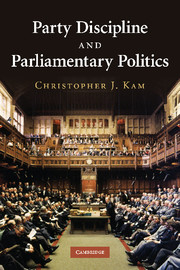Book contents
- Frontmatter
- Contents
- List of figures
- List of tables
- Acknowledgements
- 1 Introduction
- 2 A model of intra-party politics
- 3 Patterns of backbench dissent in four Westminster parliamentary systems, 1945–2005
- 4 Policy preferences and backbench dissent in Great Britain and Canada
- 5 Dissent, constituency service, and the personal vote in Great Britain and New Zealand
- 6 The cost of dissent to the party
- 7 Demotion and dissent in the Canadian Liberal Party, 1991–1997
- 8 Discipline and dissent in the Australian Coalition, 1996–1998
- 9 Career trajectories, socialization, and backbench dissent in the British House of Commons
- 10 Conclusion
- Appendix 1 Comparative statics and proofs
- Appendix 2 Content and construction of ideological scales
- Appendix 3 Sampling and coding of media dissent and discipline
- Appendix 4 Demotion and the parliamentary careers of Canadian MPs
- References
- Index
3 - Patterns of backbench dissent in four Westminster parliamentary systems, 1945–2005
Published online by Cambridge University Press: 03 July 2009
- Frontmatter
- Contents
- List of figures
- List of tables
- Acknowledgements
- 1 Introduction
- 2 A model of intra-party politics
- 3 Patterns of backbench dissent in four Westminster parliamentary systems, 1945–2005
- 4 Policy preferences and backbench dissent in Great Britain and Canada
- 5 Dissent, constituency service, and the personal vote in Great Britain and New Zealand
- 6 The cost of dissent to the party
- 7 Demotion and dissent in the Canadian Liberal Party, 1991–1997
- 8 Discipline and dissent in the Australian Coalition, 1996–1998
- 9 Career trajectories, socialization, and backbench dissent in the British House of Commons
- 10 Conclusion
- Appendix 1 Comparative statics and proofs
- Appendix 2 Content and construction of ideological scales
- Appendix 3 Sampling and coding of media dissent and discipline
- Appendix 4 Demotion and the parliamentary careers of Canadian MPs
- References
- Index
Summary
An elite body can never satisfy all the ambitions of its members; if talents and ambitions are always more numerous than places, there are bound to be many who cannot rise quickly enough by making use of the body's privileges and who seek fast promotion by attacking them.
(de Tocqueville 1848/1965, p. 265)Introduction
The LEADS model links dissent to a number of variables: the MP's electoral security, career advancement, and the like. These observable implications are developed within the context of an individual-level model of behaviour, but many can be tested equally well at the aggregate level. If, for example, advancement suppresses an MP's propensity to dissent, then parties in which opportunities for advancement are relatively abundant should experience less dissent than parties in which such opportunities are scarce. There is also scope at the aggregate level to test arguments about dissent that are not directly addressed by the model. The confidence convention stands out in this regard: it does not play a role in the model (by assumption, the MP's vote is not critical to the survival of the government), but it is a central feature of parliamentary government, and one that might be expected to influence the level of dissent that parties experience. Indeed, the impact of these sorts of institutional variables is often better studied at the aggregate level, where there is typically more room for institutional variation than at the individual level.
- Type
- Chapter
- Information
- Party Discipline and Parliamentary Politics , pp. 38 - 74Publisher: Cambridge University PressPrint publication year: 2009



